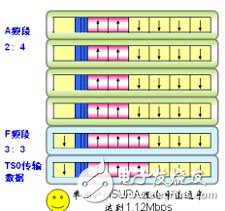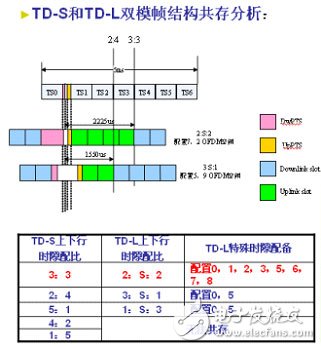With the strong support of the state, TD-SCDMA has obtained three frequency bands of F-band (1880-1900MHz), A-band (2010-2025MHz) and E-band (2320~2370MHz), with a total bandwidth of 85MHz. In these three frequency bands, F and A can be used for indoor and outdoor coverage. The E-band can only be used for indoor coverage due to military radar interference. The distribution of the three frequency bands is shown in Figure 1:

Figure 1: Available Bands for TD-SCDMA
The existing TD-SCDMA frequency band is sufficient to meet the current user development needs of China Mobile, but China Mobile has encountered the following problems in completing the network construction in these three frequency bands:
How to improve frequency utilization: how to maximize the use of existing frequency bands, provide a variety of business types to meet the needs of different users;
How to reduce the cost of network construction: Since the RRU equipment and the frequency band are closely related, how to set up multiple frequency bands, how to achieve a smooth expansion in the future after one construction;
How to smoothly evolve to TD-LTE: TD-LTE is the TD-SCDMA subsequent evolution technology, the indoor frequency of the E-band TD-LTE scale trial network, how to reuse the existing TD-SCDMA equipment to evolve to TD-LTE, reduce the evolution CAPEX.
In response to the above problems encountered by China Mobile, Datang Mobile has released a flexible high-capacity multi-band networking solution that can improve bandwidth utilization, reduce network construction costs, and solve TD-SCDMA to TD-LTE smoothing. The problem of evolution.
Second, multi-band application strategy recommendationsFor the TD-SCDMA system, F and A can be used for indoor and outdoor coverage, and the E-band can only be used for indoor coverage due to military radar interference. For the TD-LTE standard, the outdoor priority is applied to the D-band, and the F-band is supplemented. The indoor priority is applied to the E-band, and the D-band is supplemented.
Combined with the above situation, Datang Mobile's main application recommendations for the 2010 TD-SCDMA project expansion frequency band are as follows:
As the main frequency band of TD-SCDMA, the A-band is still dominated by the A-band network. In scenarios where there is a large capacity requirement and there is no PHS interference, the F-band can be introduced. It is recommended that the E-band be piloted in a small amount in the current period, mainly for indoor use, considering TD-SCDMA and TD-LTE common mode. Consider using F-band to build outdoor TD-LTE. For indoor sites with capacity requirements at this stage, considering that the terminal is immature and unable to be industrialized within 1 to 2 years of the E-band, it is recommended that the indoor large-capacity sites use the A+F band in this period. Third, different time slots in different frequency bands is the key to improve frequency utilizationCompared with other 3G communication standards such as WCDMA and CDMA2000, the flexible time slot configuration of the TD-SCDMA standard is one of its major advantages, and the time slot ratio can be flexibly adjusted according to different services. There is a band spacing of approximately 100 MHz between the F-band and the A-band, making it possible to use different time-slot ratios in the F/A band.
Datang Mobile recommends different time slot ratios for different frequency bands as follows:
The 2:4 time slot ratio reserved in the A-band can meet the downlink data services such as the existing Internet access;
In the F-band, the configuration is 3:3, and the secondary carrier TS0 is applied at the same time. The actual ratio of uplink and downlink reaches 3:4, and meets the business requirements of video surveillance and data uploading, as well as the downlink service requirements.

Figure 2: Different time slot ratio configurations in different frequency bands
Under the above configuration, the F/A dual-band downlink can provide single-user 1.68 Mbps bandwidth, and the F-band uplink can provide single-user 1.12 Mbps bandwidth.
1. Business development requires different time slots in different frequency bands.
Considering the current business development and the terminal single-carrier reality, the TD-SCDMA network service time slot ratio is configured to be 2:4, providing a single user 1.68 Mbps bandwidth to meet the downstream business development needs. With the rapid development of the Internet of Things, wireless cities, and mobile Internet, some new applications such as email delivery, interactive games, video sharing, and video surveillance continue to grow, and mobile users' demand for uplink capacity continues to increase.
However, when the service time slot ratio is 2:4, the existing network can only provide single-user uplink 560Kbps bandwidth, which obviously cannot meet the requirements of uplink service development. If the service time slot ratio is 3:3, the uplink can be The bandwidth of 1.12 Mbps is provided. As shown in Figure 3, the uplink service development needs can be met, but the downlink single-user bandwidth is insufficient, which does not meet the downstream service development requirements.

Figure 3: Single user HSUPA theoretical peak rate for different time slot switching point configurations
For the above situation, only the F and A bands are configured with different time slot ratios. For example, if the F band is configured to be 3:3 and the A band is configured to be 2:4, the uplink and downlink service development requirements can be simultaneously satisfied.
2. Different time slot ratios in different frequency bands can enhance the competitiveness of TD-SCDMA network
The single-user uplink frequency utilization rates of WCDMA, CDMA2000 and TD-SCDMA are shown in Table 1:

As can be seen from the above table, TD-SCDMA can compete with WCDMA and CDMA2000 only when the time slot ratio is 3:3.
3. Smooth evolution to TD-LTE requires different time slots in different frequency bands
In the TD-LTE system, the GP, DwPTS, and UpPTS in the special subframe can be flexibly adjusted. The two special time slots of DwPTS and UpPTS can also transmit data. If the width of the GP is larger, it means that DwPTS and UpPTS can be used for transmission. The less data, the loss of system capacity. When TD-SCDMA and TD-LTE systems coexist in the same frequency band, the GP-LTE GP size needs to be adjusted to ensure the uplink and downlink switching points are aligned, thereby avoiding interference between the two systems.
When the uplink and downlink service time slot ratio of the TD-SCDMA system is 3:3, 2:4, 5:1, it can coexist with the TD-L system. The coexistence situation is shown in Figure 4:

Figure 4: Coexistence analysis of TD-S and TD-L frame structures
Summarized from Figure 4 as follows:
When the TD-SCDMA time slot ratio is 3:3, TD-LTE adopts 2:2 subframe ratio, and the special subframe is set to configuration 7, which can achieve perfect coexistence, basically no resource loss.
Screen film cutting machine provides a complete solution to solve the pressure on finished film inventory of various mobile phone accessories suppliers. It`s suitable for individual entrepreneurship or mobile phone repair stores.
The most important is that the machine can help you solve the problems of selling and applying traditional Screen Protector films.
The advantages of screen film cutting machine are keep away from inventory pressure, low investment cost, and achieve profitability, etc.
Intelligent Mini Hydrogel Machine,Hydrogel Protector Cutter Machine,Smart Protective Film Cutter,Sticker Cutting Machine
Shenzhen TUOLI Electronic Technology Co., Ltd. , https://www.szhydrogelprotector.com